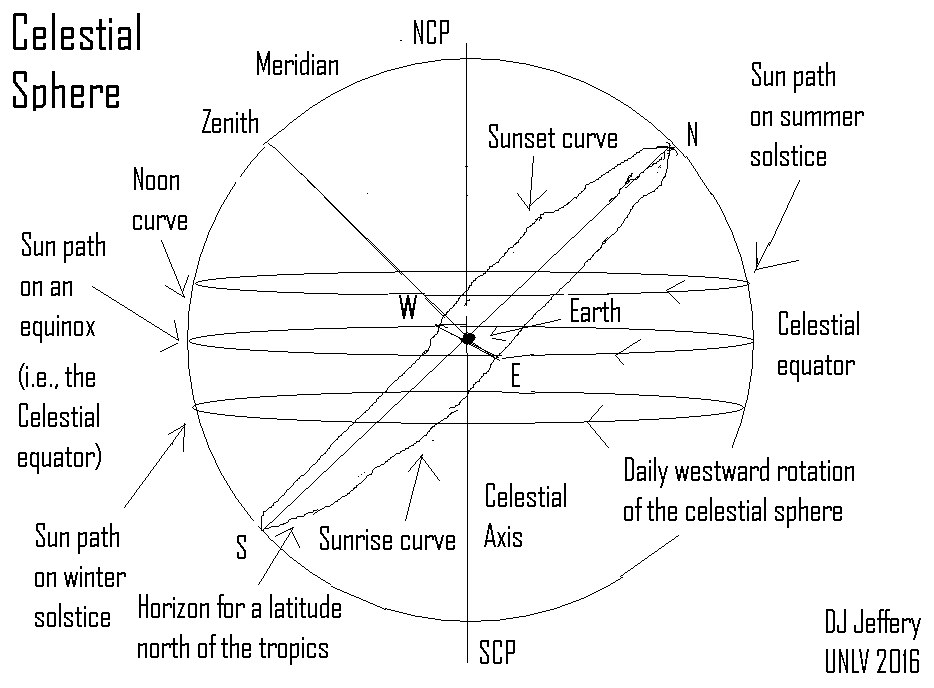
Caption: The celestial sphere, the horizon for a latitude north of the tropics, and the paths of the Sun on the solstices and equinoxes.
Features:
- The diagram is not-to-scale.
The Earth is point compared to the celestial sphere. An observer on the Earth is a point compared to the quasi-infinite plane defined by the horizon.
- The horizon is a
great circle that cuts the
celestial sphere in half.
- The observer ideally sees everything above the
horizon and nothing below.
- In the Earth-at-rest perspective,
the celestial sphere
rotates westward
one per sidereal day.
- The
sidereal day = 23:56:4.0905 = 86164.0905 s
= 1 day - 4 m + 4.0905 s (on average)
is the rotation period
relative to the
observable universe:
i.e., to the bulk mass-energy
of observable universe)---it is the true
physical-motivated
rotation period
of the Earth.
The sidereal day is ∼ 4 minutes shorter than the solar day.
The solar day is defined as solar noon to solar noon and is currently about 86400.002 s.
The standard civil day is defined as exactly 86400 s = 24 hours.
- All natural astronomical objects
are carried by the celestial sphere
as their primary apparent motion.
- The projection of the celestial axis
on the horizon plane defines
due north
and due south.
- The intersections of the horizon
and the celestial equator
define due east
and due west.
The due north-due south and due east-due west lines are perpendicular to each other.
- During the course of a solar year,
the Sun moves
eastward
on the ecliptic
(which is NOT shown for clarity in the
diagram).
- The ecliptic
is a great circle that
intersects the
celestial equator at two points:
the
vernal equinox
(0 h RA)
(AKA First Point of Aries)
and the
fall equinox.
- The ecliptic is tilted from the
celestial equator by
an angle equal to the
Earth's axial tilt 23.4°.
- The summer solstice and
winter solstice are, respectively,
the highest and lowest points in declination of the
ecliptic on the
celestial sphere.
- On the days of the
solstices and equinoxes
the Sun is carried around the daily rotation of the
celestial sphere
on the paths shown in the figure.
Diagrammatically, it should be qualitatively clear on these days where the Sun rises and sets and how long daytime and nighttime are.
- By mentally sliding the horizon plane
north and south
on the point-like
Earth,
you should be able to see how the behavior of the
sunrise,
sunset,
and
daytime
and nighttime length vary with
latitude.
- Extreme behaviors occur at the
North Pole,
South Pole,
Tropic of Cancer,
Tropic of Capricorn,
and equator.
The power of your imagination
should tell you what those behaviors are.
Image link: Itself.
Local file: local link: celestial_sphere_004_day.html.
File: Celestial sphere file: celestial_sphere_004_day.html.